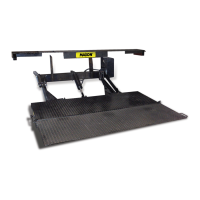11921 Slauson Ave. Santa Fe Springs, CA. 90670 (800) 227-4116 FAX (888) 771-7713
33
PLATFORM RAISES BUT LEAKS DOWN
1. Check if solenoid valves are constantly energized by
touching a screwdriver to the top nut of the solenoid
(FIG. 33-1). Try pulling the screwdriver away from the
solenoid. If the solenoid nut attracts the screwdriver
(magnetically) without pushing the toggle switch, the con-
trol circuit is operating incorrectly. Check if toggle switch,
wiring or coil are faulty.
COIL
FIG. 33-1
Keep dirt, water and other contaminants from entering the hydraulic system. Before
opening the hydraulic fl uid reservoir fi ller cap, drain plug and hydraulic lines, clean
up contaminants that can get in the openings. Also, protect the openings from
accidental contamination during maintenance.
CAUTION
2. Check the valve stem by removing the coil
assembly (Item 1, FIG. 33-2). With platform
on ground, unscrew the valve stem (Item 2,
FIG. 33-2) from the pump. Push on the plunger
that is located inside the valve stem by insert-
ing a small screwdriver blade in the end. If the
plunger does not move freely, (approximately
1/8”) replace the valve stem. When reinstall-
ing valve stem, torque hex nut to 30 in-lbs.
3. Check the hydraulic cylinder. With the platform
on the ground, remove the hydraulic line from
the vent/down port of the cylinder (FIG. 33-
3). Raise the platform even with the bed. Allow
pump motor to run two seconds more while
you watch for hydraulic fl uid at the vent/down
port. A few drops of hydraulic fl uid escaping
the vent/down port is normal; however, if it
streams from the vent/down port, piston seals
are worn. Replace seals.
RAISE PORT
VENT/DOWN PORT
FIG. 33-3
FIG. 33-2
2
1/8”
1
NOTE: In most cases, you can avoid having to manually bleed hydraulic system by
correctly positioning Liftgate platform before disconnecting any lifting cyl-
inder high pressure hydraulic lines. The following procedure can save time
and prevent accidental fl uid spills and hazards.

